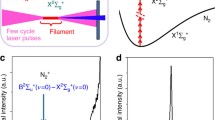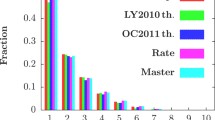Abstract
In 1954 R. H. Dicke pointed out that the spontaneous emission rate of an assembly of atoms would be much greater than that of an isolated atom.1 This effect, called superradiance, is due to cooperation of the atoms coupled via the common radiation field. In his treatment Dicke distinguished two regimes, characterized by whether the atoms are confined to a region small or large compared to the wavelength of the emitted radiation. In the former case the theoretical formulation is straightforward, and the predictions have been confirmed in the microwave region.2 For extended samples, as occur in the optical range, the theory is more complex, since propagation effects must be taken into account. Several theoretical treatments have been given, 3–8 but as yet there is no general agreement as to the details of the radiation process. Experimentally, a number of coherent optical effects closely related to the concepts used to treat superradiance had been observed. 9–15 In a recent paper16, the first observation of superradiant pulse evolution was reported in far-infrared transition of optically pumped HF gas, and an analysis was given. The present paper is a continuation and elaboration of that work.
Work supported in part by National Science Foundation and Research Corporation.
Access this chapter
Tax calculation will be finalised at checkout
Purchases are for personal use only
Preview
Unable to display preview. Download preview PDF.
Similar content being viewed by others
References
R. H. Dicke, Phys. Rev. 93, 99, (1954).
A. Abragam, The Principles of Nuclear Magnetism, (Oxford U. P., London, 1961); R. M. Hill, D. E. Kaplan, G. F. Herrmann and S. K. Ichiki, Phys. Rev. Letters. 18., 105 (1967).
V. Ernst and P. Stehle, Phys. Rev. 176, 1456 (1968).
G. S. Aggarwal, Phys. Rev. A2, 2038 (1970).
R. H. Lemberg, Phys. Rev. A2, 883 and 889 (1970).
D. Dialetis, Phys. Rev. A2, 599 (1970).
N. E. Rehler and J. H. Eberly, Phys. Rev. A3, 1735 (1971).
R. Bonifacio, P. Schwendimann, and F. Haake, Phys. Rev. A4, 302 (1971) and A4, 854 (1971).
I.D. Abella, N.A. Kurnit and S.R. Hartmann, Phys. Rev. 141, 391 (1966); C. K. N. Patel and R. E. Slusher, Phys. Rev. Letters 20, 1087 (1968).
S. L. McCall and E. L. Hahn, Phys. Rev. 183, 457 (1969).
R. E. Slusher and H. M. Gibbs, Phys. Rev. A5, 1634 (1972).
G. B. Hocker and C. L. Tang, Phys. Rev. 184, 356, (1969).
E. B. Treacy and A. J. DeMaria, Phys. Letters 29A, 369 (1969).
H. P. Grieneisen, N. A. Kurnit and A. Szöke, Opt. Commun. 3, 259 (1971).
R. G. Brewer and R. L. Shoemaker, Phys. Rev. Letters 27, 631 (1971) and R.L. Shoemaker and R. G. Brewer, Phys. Rev. Letters 28, 1430 (1972).
N. Skribanowitz, I. P. Herman, J. C. MacGillivray and M. S. Feld, Phys. Rev. Letters 30, 309 (1973)
N. Skribanowitz, I. P. Herman, R. M. Osgood, Jr., M. S. Feld and A. Javan, Appl. Phys. Letters 20, 428 (1972).
N. Skribanowitz, Ph. D. Thesis, M. I. T., 1973 (unpublished).
See, for example, L. W. Casperson and A. Yariv, IEEE J. Quantum Electron. QE-8, 80 (1972), and J. H. Parks, in Fundamental and Applied Laser Physics: Proceedings of the Esfahan Symposium, edited by M. S. Feld, N. A. Kurnit and A. Javan (Wiley, New York, 1973), and references contained therin.
D.A. Leonard, Appl. Phys. Letters 7, 4 (1965).
R. H. Dicke, in Proceedings of the Third International Conference on Quantum Electronics, Paris 1963, edited by P. Grivet and N. Bloembergen (Columbia Univ. Press, New York, 1964), p.35.
The connection between Dicke’s formalism and the semiclassical approach has been discussed by F. T. Arecchi, E. Courtens, R. Gilmore, and H. Thomas [Fundamental and Applied Laser Physics: Proceedings of the Esfahan Symposium, edited by M. S. Feld, N. A. Kurnit and A. Javan (Wiley, New York, 1973)]. The semiclassical approach has also been applied to superradiance by Friedberg and Hartman [Phys. Lett. 38A, 227 (1972)]. A promising analysis whish is fully quantum mechanical has been given by Willis and Picard [Phys. Rev. A, to be published(Sep.,1973)].
N. Skribanowitz, I. P. Herman and M. S. Feld, Appl. Phys. Lett. 21, 466 (1972).
R. G. Wenzel and G. P. Arnold, IEEE J. Quantum Electron. QE-8, 26 (1972).
We are grateful to Bob Wenzel of Los Alamos Scientific Laboratory for providing plans for this laser.
J. D. Jackson, Classical Electrodynamics, (John Wiley and Sons, New York, 1962).
F. Bloch, Phys. Rev. 70, 460 (1946).
A. Icsevgi and W. E. Lamb, Jr., Phys. Rev. 185, 517 (1969).
See, for example, Ref. 28; F. A. Hopf and M. D. Scully, Phys. Rev. 179, 399 (1969); and Ref. 10. For a comprehensive list of references, see G. L. Lamb, Jr., Rev. Mod. Phys. 43, 99 (1971).
J.C. MacGillivray, I.P. Herman, N. Skribanowitz and M.S. Feld, Phys. Rev. A, to be published.
This formula is a consequence of the optical pumping process and is not in any way basic to the superradiant pulse evolution process.
R. Friedberg and S. R. Hartmann, Phys. Lett. 37 A. 285 (1971).
C. K. Rhodes, A. Szöke and A. Javan, Phys. Rev. Letters 21, 1151 (1968).
J. A. Fleck, Jr. [Phys. Rev. B1, 84 (1970)] has considered a related problem in which spatial variations are neglected.
In a long sample where the transit time is greater than TR, the sample can break up into independently radiating sections. This effect is related to the cooperation length described by F. T. Arecchi and E. Courtens [Phys. Rev. A2, 1730 (1970)]. Further discussion of such effects will be given in Ref. 30.
R. P. Feynman, F. L. Vernon, Jr., and R. W. Hellwarth, J. Appl. Phys. 28, 49 (1957).
D. C. Burnham and R. Y. Chiao, Phys. Rev. 188, 667 (1969); see also G. L. Lamb, Jr., Phys. Letters 29A, 507 (1969), and F. T. Arecchi and E. Courtens (Ref. 35).
M.D. Crisp, Phys. Rev. A1, 1604 (1970).
Note that this conclusion applies only to an inhomogeneously broadened system, where de-excitation of the levels is unimportant. The population decay associated with homogeneous broadening cannot be counteracted by high gain.
N. Tan-no, K. Kan-no, K. Yokoto and H. Inaba, IEEE J. Quantum Electron. QE-9, 423 (1973).
Author information
Authors and Affiliations
Editor information
Editors and Affiliations
Rights and permissions
Copyright information
© 1974 Plenum Press, New York
About this chapter
Cite this chapter
Herman, I.P., MacGillivray, J.C., Skribanowitz, N., Feld, M.S. (1974). Self-Induced Emission in Optically Pumped HF Gas: The Rise and Fall of the Superradiant State. In: Brewer, R.G., Mooradian, A. (eds) Laser Spectroscopy. Springer, Boston, MA. https://doi.org/10.1007/978-1-4613-4517-6_28
Download citation
DOI: https://doi.org/10.1007/978-1-4613-4517-6_28
Publisher Name: Springer, Boston, MA
Print ISBN: 978-1-4613-4519-0
Online ISBN: 978-1-4613-4517-6
eBook Packages: Springer Book Archive




